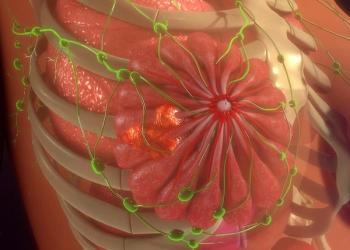
Oncology NEWS International
- Oncology NEWS International Vol 7 No 10
- Volume 7
- Issue 10
Device Finds Breast Lesions by Measuring Electropotentials
LONDON--A multicenter clinical study has shown that a new noninvasive diagnostic modality, which measures electropotentials at the skin surface in the region of a suspicious breast lesion, helps physicians discriminate benign lesions from breast cancer.
LONDON--A multicenter clinical study has shown that a new noninvasive diagnostic modality, which measures electropotentials at the skin surface in the region of a suspicious breast lesion, helps physicians discriminate benign lesions from breast cancer.
The device, developed by Biofield Corp., Atlanta, is similar to an electrocardiogram in that measurements from the skin surface are made with noninvasive sensors (figure). Data suggest that rapidly proliferating cells, typical of cancer, lose their normal charge or polarity, resulting in depolarization, which can be measured by the devices sensors.
Researchers at eight European medical centers compared biopsy results with Biofield test results in 661 women who underwent biopsy of a suspicious breast lesion (Lancet 351:359-363, 1998). The test provided highly significant predictive information only in women with palpable lesions. Specificity was 55% with 90% sensitivity for women with palpable lesions using an index based on electro-potential differences and age.
"The lack of discrimination for nonpalpable lesions may be related to difficulty with accurate sensor placement . . . based on localization from mammograms," said Jack Cuzick, PhD, lead author of the study and head of the Prevention and Control Section of the Imperial Cancer Research Fund (ICRF).
Thus, the researchers concluded that the most promising use for the new technique may be in women with lumps or inconclusive nodularity detected on physical exam. "The prevalence of cancer in such women is low, especially when they are young, and a simple test that could reliably rule out malignant disease would help keep the number of diagnostic tests done on these women to a minimum," Dr. Cuzick said.
As a example, in a referral population with a 5% prevalence of cancer, the Biofield test, operating with 90% sensitivity, would have a negative predictive value of 99.1%, and would reduce the number of women requiring additional tests by more than half.
The Biofield Diagnostic System will require pre-market approval (PMA) from the FDA. It is scheduled to be available in Europe by late 1998.
Articles in this issue
about 27 years ago
Panel Recommends Photofrin for Use in Late-Stage Lung Cancerabout 27 years ago
California Intervention Raises Consumption of Fruits and Vegetablesabout 27 years ago
ODAC Panel Okays Nolvadex to Reduce Breast Cancer Riskabout 27 years ago
Evolving Role for Preoperative Chemo in Breast Cancerabout 27 years ago
NCI Sets Sail on a New Tack In the Stormy Seas of CAMabout 27 years ago
Opioid Antagonists Can Control Opioid-Induced Constipationabout 27 years ago
NCI Seeks New Technologiesabout 27 years ago
NIAID Collaborates With VaxGen, Inc. on Trials of AIDSVAXabout 27 years ago
Clinicians Often Fail To Provide Adequate Genetic CounselingNewsletter
Stay up to date on recent advances in the multidisciplinary approach to cancer.



















































































